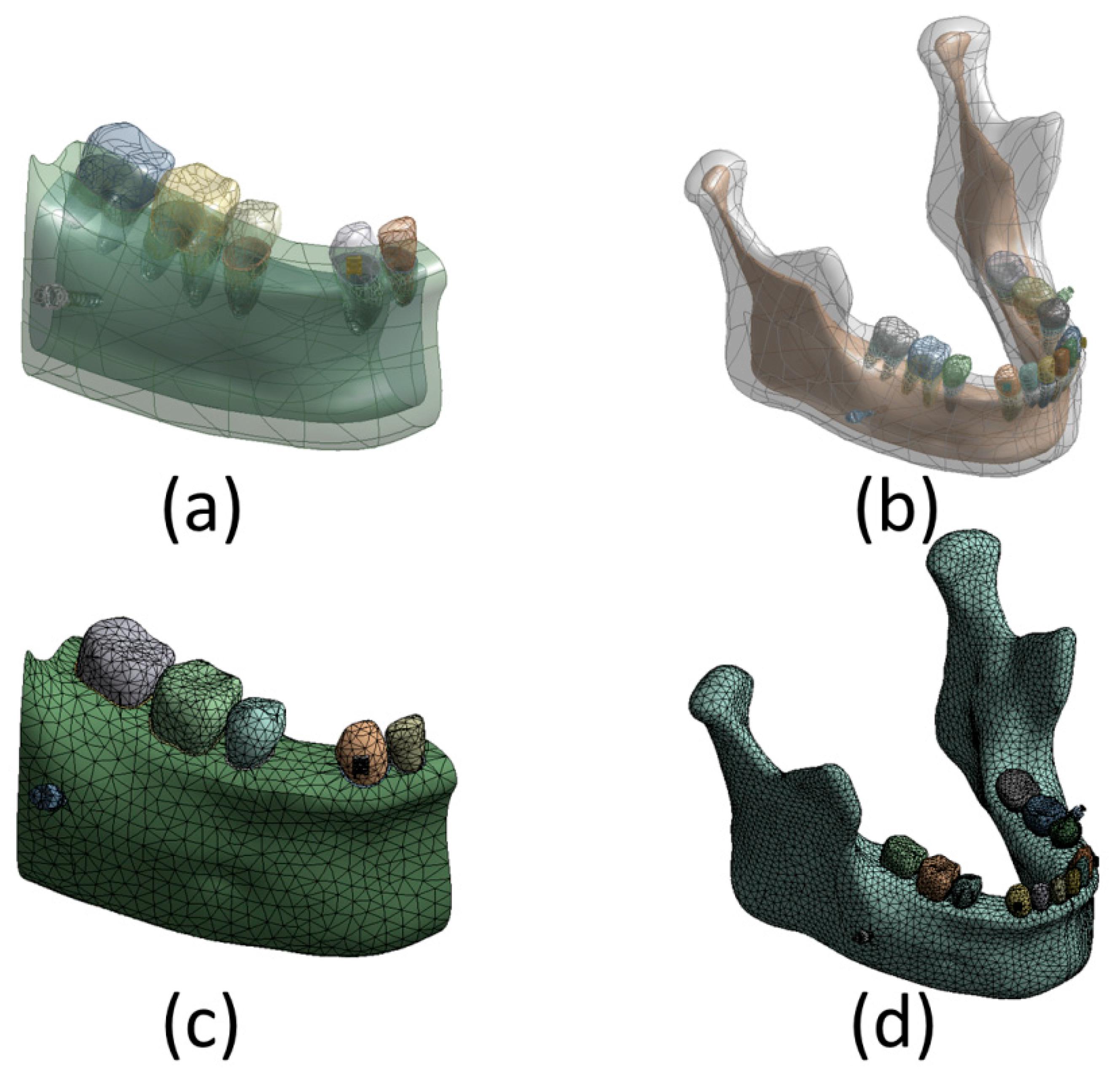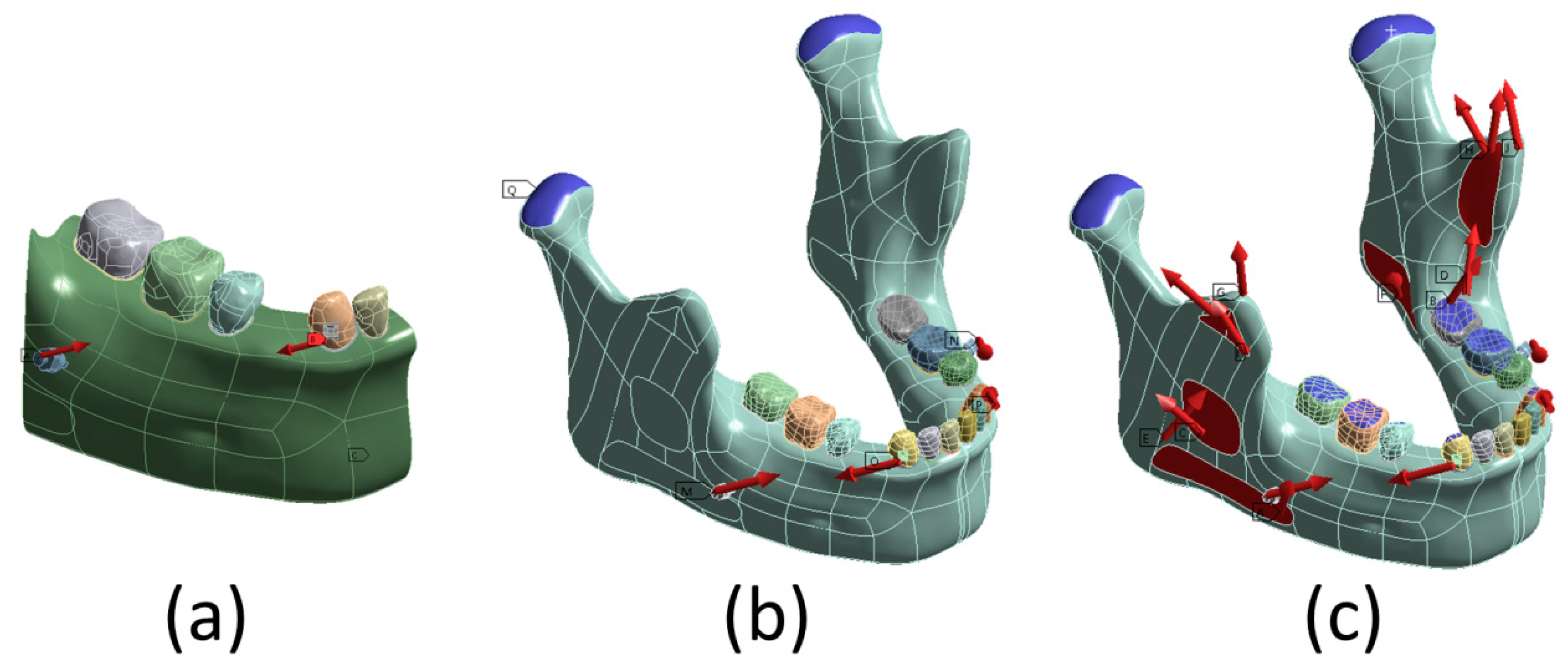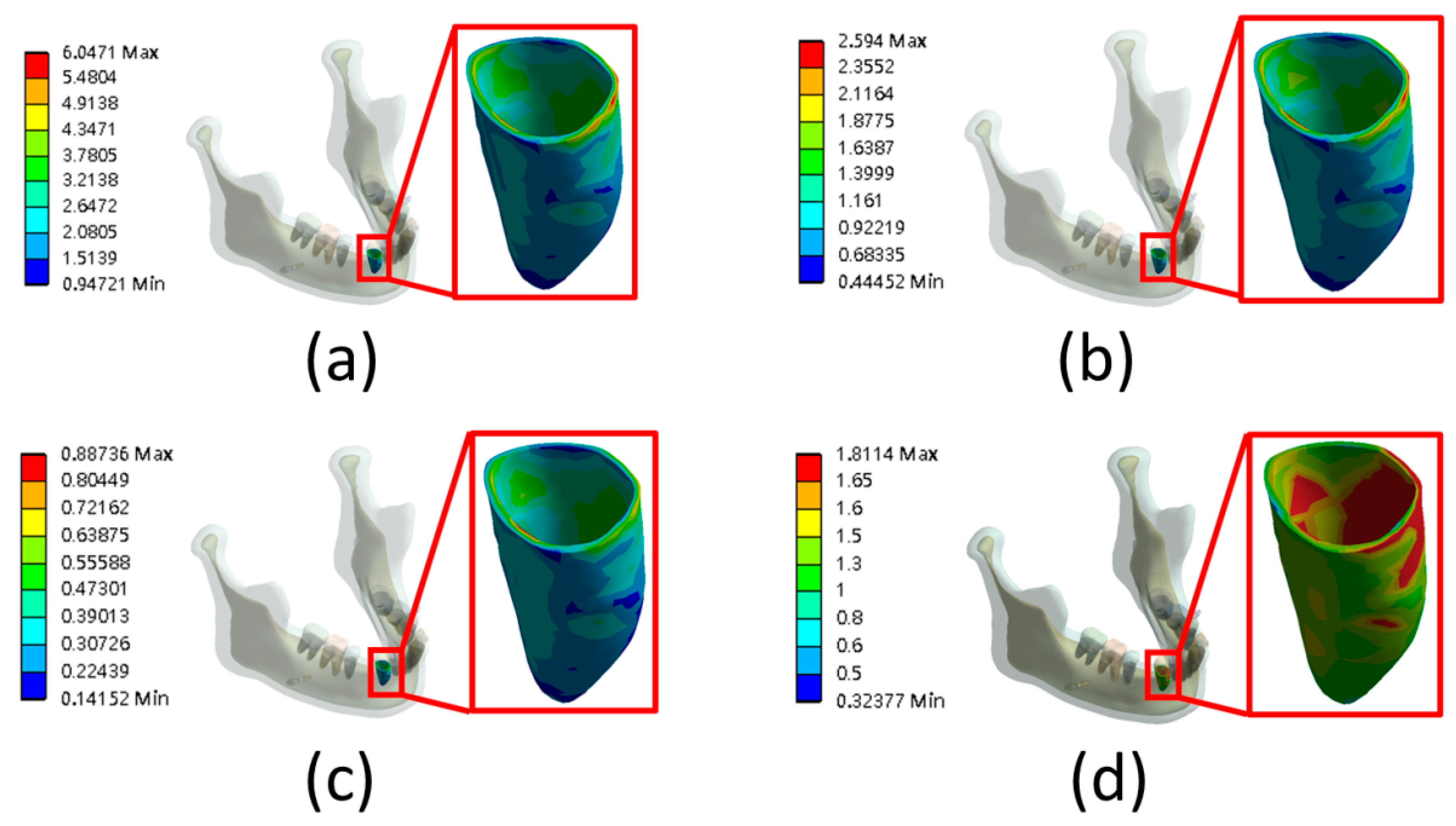Mandible Integrity and Material Properties of the Periodontal Ligament during Orthodontic Tooth Movement: A Finite-Element Study
Abstract
1. Introduction
2. Materials and Methods
2.1. Geometry of the Finite-Element Model
2.2. Material Properties of the Finite-Element Model
2.3. Loading and Boundary Conditions
2.4. Evaluation Parameters
3. Results
3.1. Effect of Mandibular Integrity on the Simulation Results
3.2. Effect of PDL Material Properties on the Simulation Results
3.3. Effect of Mandibular Integrity and PDL Material Properties on Bone
4. Discussion
5. Conclusions
Author Contributions
Funding
Conflicts of Interest
References
- Hsu, M.-L.; Chang, C.-L. Application of Finite Element Analysis in Dentistry. Finite Elem. Anal. Sciyo 2010. [Google Scholar] [CrossRef]
- Piccioni, M.A.R.; Campos, E.A.; Saad, J.R.C.; de Andrade, M.F.; Galvão, M.R.; Rached, A.A. Application of the finite element method in Dentistry. RSBO Rev. Sul-Bras. Odontol. 2013, 10, 369–377. [Google Scholar]
- Cattaneo, P.; Dalstra, M.; Melsen, B. Strains in periodontal ligament and alveolar bone associated with orthodontic tooth movement analyzed by finite element. Orthod. Craniofacial Res. 2009, 12, 120–128. [Google Scholar] [CrossRef] [PubMed]
- Chang, H.-W.; Huang, H.-L.; Yu, J.-H.; Hsu, J.-T.; Li, Y.-F.; Wu, Y.-F. Effects of orthodontic tooth movement on alveolar bone density. Clin. Oral Investig. 2012, 16, 679–688. [Google Scholar] [CrossRef] [PubMed]
- Masella, R.S.; Meister, M. Current concepts in the biology of orthodontic tooth movement. Am. J. Orthod. Dentofac. Orthop. 2006, 129, 458–468. [Google Scholar] [CrossRef] [PubMed]
- Will, L.A. Orthodontic Tooth Movement: A Historic Prospective. Front Oral Biol. 2016, 18, 46–55. [Google Scholar]
- Tanne, K.; Sakuda, M.; Burstone, C.J. Three-dimensional finite element analysis for stress in the periodontal tissue by orthodontic forces. Am. J. Orthod. Dentofac. Orthop. 1987, 92, 499–505. [Google Scholar] [CrossRef]
- Sardarian, A.; Shahidi, S.; Boushehri, S.G.; Geramy, A. The effect of vertical bracket positioning on torque and the resultant stress in the periodontal ligament—A finite element study. Prog. Orthod. 2014, 15, 50. [Google Scholar] [CrossRef][Green Version]
- Sugii, M.M.; Barreto, B.C.F.; Francisco Vieira-Junior, W.; Simone, K.R.I.; Bacchi, A.; Caldas, R.A. Extruded upper first molar intrusion: Comparison between unilateral and bilateral miniscrew anchorage. Dent. Press J. Orthod. 2018, 23, 63–70. [Google Scholar] [CrossRef]
- Caballero, G.M.; de Carvalho Filho, O.A.; Hargreaves, B.O.; de Araújo Brito, H.H.; Junior, P.A.A.M.; Oliveira, D.D. Mandibular canine intrusion with the segmented arch technique: A finite element method study. Am. J. Orthod. Dentofac. Orthop. 2015, 147, 691–697. [Google Scholar] [CrossRef]
- Field, C.; Ichim, I.; Swain, M.V.; Chan, E.; Darendeliler, M.A.; Li, W.; Li, Q. Mechanical responses to orthodontic loading: A 3-dimensional finite element multi-tooth model. Am. J. Orthod. Dentofac. Orthop. 2009, 135, 174–181. [Google Scholar] [CrossRef] [PubMed]
- Gerami, A.; Dadgar, S.; Rakhshan, V.; Jannati, P.; Sobouti, F. Displacement and force distribution of splinted and tilted mandibular anterior teeth under occlusal loads: An in silico 3D finite element analysis. Prog. Orthod. 2016, 17, 16. [Google Scholar] [CrossRef] [PubMed][Green Version]
- Liao, Z.; Elekdag-Turk, S.; Turk, T.; Grove, J.; Dalci, O.; Chen, J.; Zheng, K.; Ali Darendeliler, M.; Swain, M.; Li, Q. Computational and clinical investigation on the role of mechanical vibration on orthodontic tooth movement. J. Biomech. 2017, 60, 57–64. [Google Scholar] [CrossRef] [PubMed]
- Zhou, X.; Xia, Z.; Gan, Y.; Zhang, D.; Xiong, J.; Fang, P.; Li, G.; Zhao, Q. Orthodontic force simulation of Tooth-PDL-Bone Complex under archwire loading. In Proceedings of the 38th Annual International Conference of the IEEE Engineering in Medicine and Biology Society (EMBC), Lake Buena Vista, FL, USA, 16–20 August 2016; pp. 6030–6033. [Google Scholar]
- Namburi, M.; Nagothu, S.; Kumar, C.S.; Chakrapani, N.; Hanumantharao, C.H.; Kumar, S.K. Evaluating the effects of consolidation on intrusion and retraction using temporary anchorage devices—A FEM study. Prog. Orthod. 2017, 18, 2. [Google Scholar] [CrossRef][Green Version]
- Chen, J.; Li, W.; Swain, M.V.; Ali Darendeliler, M.; Li, Q. A periodontal ligament driven remodeling algorithm for orthodontic tooth movement. J. Biomech. 2014, 47, 1689–1695. [Google Scholar] [CrossRef]
- Bouton, A.; Simon, Y.; Goussard, F.; Teresi, L.; Sansalone, V. New finite element study protocol: Clinical simulation of orthodontic tooth movement. Int. Orthod. 2017, 15, 165–179. [Google Scholar] [CrossRef]
- de Souza, F.I.; Poi, W.R.; da Silva, V.F.; Martini, A.P.; Melo, R.A.; Panzarini, S.R.; Rocha, E.P. Stress distribution in delayed replanted teeth splinted with different orthodontic wires: A three-dimensional finite element analysis. Dent. Traumatol. 2015, 31, 190–195. [Google Scholar] [CrossRef]
- McCormack, S.W.; Witzel, U.; Watson, P.J.; Fagan, M.J.; Groening, F. Inclusion of periodontal ligament fibres in mandibular finite element models leads to an increase in alveolar bone strains. PLoS ONE 2017, 12, e0188707. [Google Scholar] [CrossRef]
- Salehi, P.; Gerami, A.; Najafi, A.; Torkan, S. Evaluating stress distribution pattern in periodontal ligament of maxillary incisors during intrusion assessed by the finite element method. J. Dent. 2015, 16, 314–322. [Google Scholar]
- Kawarizadeh, A.; Bourauel, C.; Jäger, A. Experimental and numerical determination of initial tooth mobility and material properties of the periodontal ligament in rat molar specimens. Eur. J. Orthod. 2003, 25, 569–578. [Google Scholar] [CrossRef]
- Poppe, M.; Bourauel, C.; Jäger, A. Determination of the elasticity parameters of the human periodontal ligament and the location of the center of resistance of single-rooted teeth a study of autopsy specimens and their conversion into finite element models. J. Orofac. Orthop. Fortschr. Kieferorthopädie 2002, 63, 358–370. [Google Scholar] [CrossRef] [PubMed]
- Ziegler, A.; Keilig, L.; Kawarizadeh, A.; Jäger, A.; Bourauel, C. Numerical simulation of the biomechanical behaviour of multi-rooted teeth. Eur. J. Orthod. 2005, 27, 333–339. [Google Scholar] [CrossRef] [PubMed]
- Liu, T.-C.; Chang, C.-H.; Wong, T.-Y.; Liu, J.-K. Finite element analysis of miniscrew implants used for orthodontic anchorage. Am. J. Orthod. Dentofac. Orthop. 2012, 141, 468–476. [Google Scholar] [CrossRef] [PubMed]
- Hartmann, M.; Dirk, C.; Reimann, S.; Keilig, L.; Konermann, A.; Jager, A.; Bourauel, C. Influence of tooth dimension on the initial mobility based on plaster casts and X-ray images: A numerical study. J. Orofac. Orthop. 2017, 78, 285–292. [Google Scholar] [CrossRef]
- Verna, C.; Cattaneo, P.M.; Dalstra, M. Corticotomy affects both the modus and magnitude of orthodontic tooth movement. Eur. J. Orthod. 2018, 40, 107–112. [Google Scholar] [CrossRef]
- Papageorgiou, S.N.; Keilig, L.; Hasan, I.; Jäger, A.; Bourauel, C. Effect of material variation on the biomechanical behaviour of orthodontic fixed appliances: A finite element analysis. Eur. J. Orthod. 2016, 38, 300–307. [Google Scholar] [CrossRef]
- Papageorgiou, S.N.; Keilig, L.; Vandevska-Radunovic, V.; Eliades, T.; Bourauel, C. Torque differences due to the material variation of the orthodontic appliance: A finite element study. Prog. Orthod. 2017, 18, 6. [Google Scholar] [CrossRef]
- Wu, J.-H.; Wang, H.-C.; Chen, C.-M.; Lu, P.-C.; Lai, S.-T.; Lee, K.-T.; Du, J.-K. Pullout strengths of orthodontic palatal mini-implants tested in vitro. J. Dent. Sci. 2011, 6, 200–204. [Google Scholar] [CrossRef]
- Leung, M.T.-C.; Lee, T.C.-K.; Rabie, A.B.M.; Wong, R.W.-K. Use of miniscrews and miniplates in orthodontics. J. Oral Maxillofac. Surg. 2008, 66, 1461–1466. [Google Scholar] [CrossRef]
- Cattaneo, P.; Dalstra, M.; Melsen, B. The finite element method: A tool to study orthodontic tooth movement. J. Dent. Res. 2005, 84, 428–433. [Google Scholar] [CrossRef]
- Korioth, T.; Hannam, A. Deformation of the human mandible during simulated tooth clenching. J. Dent. Res. 1994, 73, 56–66. [Google Scholar] [CrossRef] [PubMed]
- Koolstra, J.; Van Eijden, T. Three-dimensional dynamical capabilities of the human masticatory muscles. J. Biomech. 1999, 32, 145–152. [Google Scholar] [CrossRef]
- Pöschke, A.; Krähling, B.; Failing, K.; Staszyk, C. Molecular characteristics of the equine periodontal ligament. Front. Vet. Sci. 2018, 4, 235. [Google Scholar] [CrossRef] [PubMed]
- Hongo, M.; Gay, R.E.; Hsu, J.-T.; Zhao, K.D.; Ilharreborde, B.; Berglund, L.J.; An, K.-N. Effect of multiple freeze–thaw cycles on intervertebral dynamic motion characteristics in the porcine lumbar spine. J. Biomech. 2008, 41, 916–920. [Google Scholar] [CrossRef] [PubMed]
- Hemanth, M.; Deoli, S.; Raghuveer, H.; Rani, M.; Hegde, C.; Vedavathi, B. Stress induced in periodontal ligament under orthodontic loading (Part II): A comparison of linear versus non-linear FEM study. J. Int. Oral Health JIOH 2015, 7, 114–118. [Google Scholar] [PubMed]




| Component | Elastic Modulus (MPa) | Poisson’s Ratio | Reference | |
|---|---|---|---|---|
| Bracket | 230000 | 0.3 | Wu et al., 2011 [29] | |
| Miniscrew | ||||
| Cortical bone | 14900 | 0.3 | Poppe et al., 2002 [22] | |
| Cancellous bone | 460 | 0.3 | ||
| Tooth | 18600 | 0.3 | Leung et al., 2008 [30] | |
| PDL | Low linear elastic | 0.044 | 0.45 | Cattaneo et al., 2005 [31] |
| Middle linear elastic | 0.17 | 0.45 | Cattaneo et al., 2005 [31] | |
| High linear elastic | 0.68 | 0.45 | Salehi et al., 2015 [20] | |
| Bilinear elastic | E1 = 0.15; E2 = 0.50; | 0.3 | Kawarizadeh et al., [21] Poppe et al., 2002 [22] | |
| Ultimate strain E12: 6.3% | ||||
| Occlusal Mode | Side | Direction | Muscular Force (N) | |||||
|---|---|---|---|---|---|---|---|---|
| SM | DM | MP | AT | MT | PT | |||
| Intercuspal position (ICP) | Right | Force | 76.2 | 21.2 | 136.3 | 12.6 | 5.7 | 3.0 |
| FX | −15.8 | −11.6 | 66.3 | −1.9 | −1.3 | −0.6 | ||
| FY | −31.9 | 7.6 | −50.9 | −0.6 | 2.9 | 2.6 | ||
| FZ | 67.3 | 16.1 | 107.8 | 12.5 | 4.8 | 1.4 | ||
| Left | Force | 76.2 | 21.2 | 136.3 | 12.6 | 5.7 | 3.0 | |
| FX | 15.8 | 11.6 | −66.3 | 1.9 | 1.3 | 0.6 | ||
| FY | −31.9 | 7.6 | −50.9 | −0.6 | 2.9 | 2.6 | ||
| FZ | 67.3 | 16.1 | 107.8 | 12.5 | 4.8 | 1.4 | ||
| Investigated issue: Integrity of mandible | Investigated issue: Material property of PDL | ||||||
|---|---|---|---|---|---|---|---|
| Model No. | Model 1 | Model 2 | Model 3 | Model 4 | Model 5 | Model 6 | Model 7 |
| Mandibular bone | Partial mandible | Complete mandible | |||||
| Material property of PDL | Bilinear elastic | Low linear elastic | Middle linear elastic | High linear elastic | Bilinear elastic | ||
| Loading condition | Orthodontic force | Orthodontic force and ICP occlusal force | |||||
| Boundary condition | Constrained the distal and missal side of partial mandible | Constrained the top of condyle | Constrained the top of the condyle and incisor regions | ||||
| Investigated Issue: Integrity of Mandible | Investigated Issue: Material | ||||||
|---|---|---|---|---|---|---|---|
| Model 1 | Model 2 | Model 3 | Model 4 | Model 5 | Model 6 | Model 7 | |
| Max von Mises strain on canine’s PDL | 0.461 | 0.394 | 1.811 | 6.047 | 2.594 | 0.887 | 1.811 |
| Max von Mises stress on cortical bone around canine’s PDL | 0.498 | 0.765 | 7.5375 | 6.25 | 8.3067 | 14.343 | 7.5375 |
| Max von Mises stress on cancellous bone around canine’s PDL | 0.0599 | 0.0794 | 0.6914 | 0.5622 | 1.2387 | 1.5905 | 0.6914 |
© 2020 by the authors. Licensee MDPI, Basel, Switzerland. This article is an open access article distributed under the terms and conditions of the Creative Commons Attribution (CC BY) license (http://creativecommons.org/licenses/by/4.0/).
Share and Cite
Huang, H.-L.; Tsai, M.-T.; Yang, S.-G.; Su, K.-C.; Shen, Y.-W.; Hsu, J.-T. Mandible Integrity and Material Properties of the Periodontal Ligament during Orthodontic Tooth Movement: A Finite-Element Study. Appl. Sci. 2020, 10, 2980. https://doi.org/10.3390/app10082980
Huang H-L, Tsai M-T, Yang S-G, Su K-C, Shen Y-W, Hsu J-T. Mandible Integrity and Material Properties of the Periodontal Ligament during Orthodontic Tooth Movement: A Finite-Element Study. Applied Sciences. 2020; 10(8):2980. https://doi.org/10.3390/app10082980
Chicago/Turabian StyleHuang, Heng-Li, Ming-Tzu Tsai, Shih-Guang Yang, Kuo-Chih Su, Yen-Wen Shen, and Jui-Ting Hsu. 2020. "Mandible Integrity and Material Properties of the Periodontal Ligament during Orthodontic Tooth Movement: A Finite-Element Study" Applied Sciences 10, no. 8: 2980. https://doi.org/10.3390/app10082980
APA StyleHuang, H.-L., Tsai, M.-T., Yang, S.-G., Su, K.-C., Shen, Y.-W., & Hsu, J.-T. (2020). Mandible Integrity and Material Properties of the Periodontal Ligament during Orthodontic Tooth Movement: A Finite-Element Study. Applied Sciences, 10(8), 2980. https://doi.org/10.3390/app10082980





